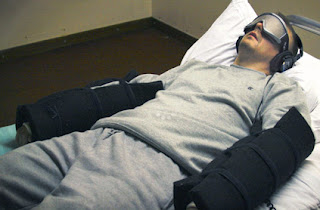1. Explain in detail what "savant syndrome" means.
-Savant Syndrome is an infrequent condition in which a person with various disorders, including the autistic disorder, has a spectacular and brilliant ability. This condition can either be genetic or acquired through a brain injury later in childhood or adult life.
-People who have the savant syndrome also have an autistic disorder, mental retardation, or a brain injury that occurs before, during, or after birth. It turns out to be that 50% of the persons with savant syndrome have autistic disorder.
-The most common savant abilities are called “splinter skills.” These skills refer to memorization of music, numbers, maps, or historical facts. Music, artistic talent, and calendar calculating are common among savants. Two types of savants include talented savants and prodigious savants. A prodigious savant, though, is one who has an outstanding and spectacular skill. There are fewer than 50 prodigious savants worldwide.
-Savant Syndrome occurs four to six times more frequently in males than females. This is because the autistic disorder is seen more in the male gender. High levels of testosterone in the male fetus produce brain injury in the left hemisphere, therefore causing mental disabilities such as the autistic disorder.
2. What does genius mean? Explain the difference between genius and savant.
-A genius is a person who is not only incredibly intelligent, but also extraordinarily creative. Geniuses use their intelligence and imagination to discover and invent things. Most geniuses have high IQ scores and are multi-talented in various fields. While a genius is versatile, a savant is only amazingly brilliant in one area. Hence, savants are not considered geniuses because they are not good at everything. 3. What is a stroke and how could it affect your mental functioning?
-A stroke, or “brain attack,” is a condition in where a blood clot or ruptured artery/blood vessel interrupts blood flow into the brain. This produces a lack of oxygen and glucose to the brain, leading to a brain injury and the death of brain cells.
-A stroke may result in an impairment of speech, movement, and memory. Smaller strokes result in a weakness of arms and legs, while a larger stroke may lead to death or paralysis. People who have suffered from strokes are left with weakness in one side of the body, bladder problems, and difficulty in speaking.

4. What is a functional MRI and how does it help us understand brain activity?
-A functional MRI is a device used to measure brain activity. According Dr. Paul Christo, the functional MRI, “tracks an increase of blood flow to specific blood vessels that accompanies neural activity in the brain.”
-The functional Magnetic Resonance Imaging (MRI) is used to study the anatomy of the brain, to determine which part of the brain is responsible for critical functions (speech, thought, movement), to evaluate the effect of strokes and other diseases on the brain, and to supervise any brain tumors. 
5. What is the corpus callosum and what role does it play in your brain's activity?-The corpus callosum is a wide, flat group of nerve fibers that connect the Right and Left Hemispheres of the brain. It is made up of 200-250 million nerve fibers. According to some studies, the corpus callosum is 11% larger in left-handed people than in right-handed people.
-The main role of the corpus callosum is to facilitate the connection and communication between the Right and Left Hemispheres. It permits them to exchange information rapidly and precisely.
6. What is epilepsy and how might it affect your brain's abilities? -Epilepsy is a brain disorder in which neurons signal unusually. During epilepsy, the regular pattern of neuronal activity becomes disturbed, causing “strange sensations, emotions, and behavior, sometimes convulsions, muscle spasms, and loss of consciousness.” Neurons may fire as many as 500 times a second.
-This disorder is caused by seizures; it is not caused by a mental illness. If severe, though, epilepsy may cause brain damage.
7. What is autism?
-Autism is a complex developmental disability. It is a neurological disorder that affects the normal brain function, causing a person to have issues with his or her communication and social skills. It is widely believed that autism appears during the first three years of a person’s life.
-People with autism make little eye contact, do not like physical contact, and find loud noises really unpleasant. Most of the people that suffer from autism have repetitive behaviors (routines) and severe problems with their speaking skills.
8. What is Asperger's Syndrome? -Clinicians define Asperger’s Syndrome to be, “persons who are at the high functioning end of the Pervasive Developmental Disorders and Autistic Disorders spectrum.” Asperger’s Syndrome shares many characteristics with autism: unusual memory, social uneasiness, strong attachments to objects, and obsession to sameness (routines). People who suffer from Asperger’s Syndrome, though, have an unusual interest in natural sciences, complex calculations, and computer programming; have an early development in language skills, and more social skills than those people with autistic disorders. Savant skills are prominent in people who have Asperger’s Syndrome
-----------------------------------------------------------------------------------
Links:
-Information:
http://www.wisconsinmedicalsociety.org/savant_syndrome/frequently_asked_questions#q1
http://www.medicalnewstoday.com/info/autism/
http://www.wisegeek.com/what-is-a-genius.htm
http://www.medicalnewstoday.com/articles/7624.php
http://www.radiologyinfo.org/en/info.cfm?pg=fmribrain
http://www.buzzle.com/articles/corpus-callosum-function.html
http://www.medicinenet.com/seizure/article.htm
-Photos:
http://2.bp.blogspot.com/_pashdf8IiYY/SnLtMxDKcqI/AAAAAAAAAeM/glGQGUH7Z44/s1600-h/Savants.jpg
http://web.mac.com/jrc/Genius/Genius256.jpg
http://4.bp.blogspot.com/_7zQULPNQ7FQ/S73du7iJGvI/AAAAAAAAAmg/M-BQ2wcj6WE/s400/17133.jpg
http://biologybiozine.com/images/tech_09.jpg
http://blog.lib.umn.edu/trite001/studyinghumananatomyandphysiology/8753.jpg
http://autismawarenessjewellery.com/wp-content/uploads/2010/02/einstein-raz-271x300.jpg




















